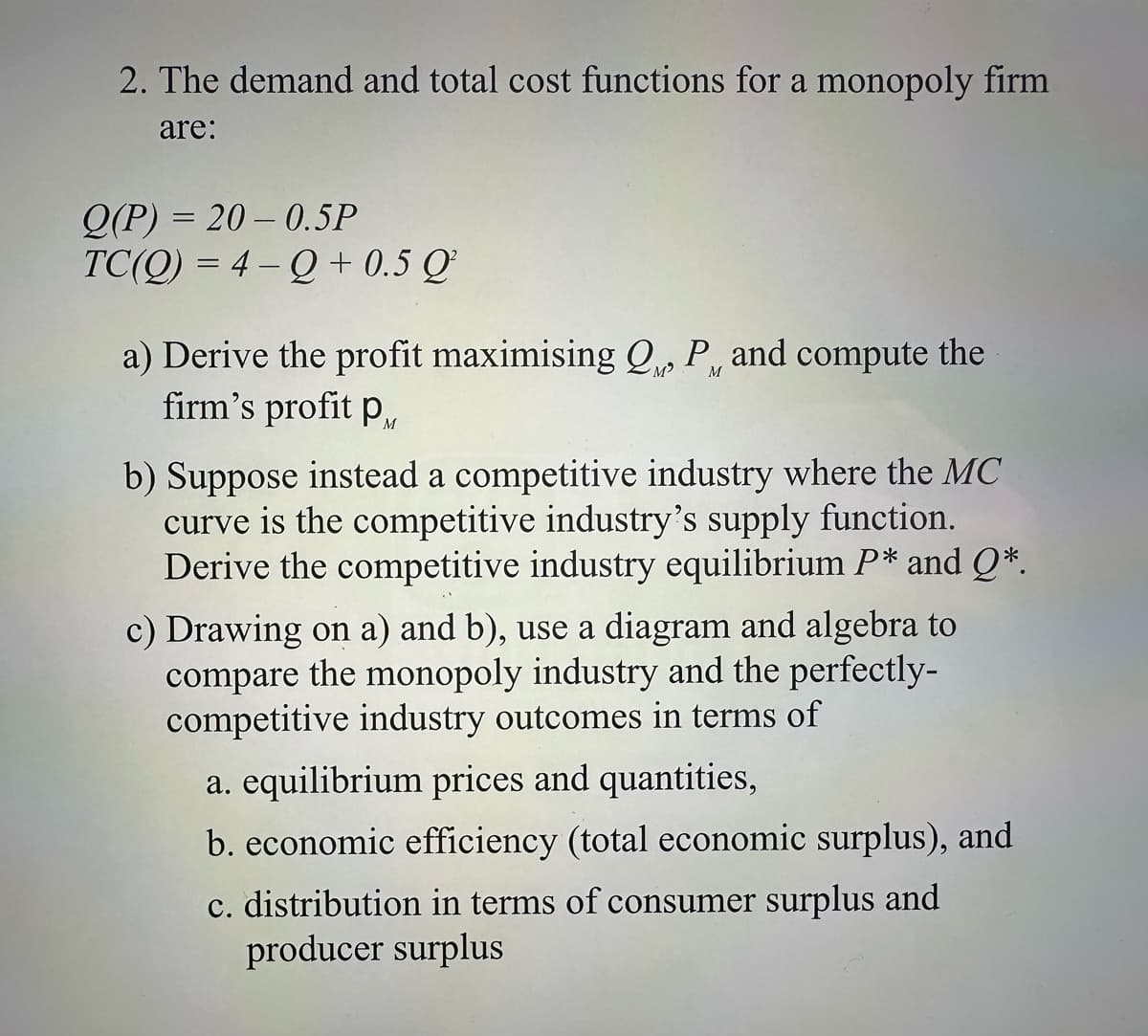2. The demand and total cost functions for a monopoly firm are: Q(P) = 20-0.5P TC(Q)=4-Q + 0.5 Q M a) Derive the profit maximising Q, P, and compute the firm's profit p b) Suppose instead a competitive industry where the MC curve is the competitive industry's supply function. Derive the competitive industry equilibrium P* and Q*. c) Drawing on a) and b), use a diagram and algebra to compare the monopoly industry and the perfectly- competitive industry outcomes in terms of a. equilibrium prices and quantities, b. economic efficiency (total economic surplus), and c. distribution in terms of consumer surplus and producer surplus
2. The demand and total cost functions for a monopoly firm are: Q(P) = 20-0.5P TC(Q)=4-Q + 0.5 Q M a) Derive the profit maximising Q, P, and compute the firm's profit p b) Suppose instead a competitive industry where the MC curve is the competitive industry's supply function. Derive the competitive industry equilibrium P* and Q*. c) Drawing on a) and b), use a diagram and algebra to compare the monopoly industry and the perfectly- competitive industry outcomes in terms of a. equilibrium prices and quantities, b. economic efficiency (total economic surplus), and c. distribution in terms of consumer surplus and producer surplus
Managerial Economics: Applications, Strategies and Tactics (MindTap Course List)
14th Edition
ISBN:9781305506381
Author:James R. McGuigan, R. Charles Moyer, Frederick H.deB. Harris
Publisher:James R. McGuigan, R. Charles Moyer, Frederick H.deB. Harris
Chapter11: Price And Output Determination: Monopoly And Dominant Firms
Section: Chapter Questions
Problem 4E
Related questions
Question

Transcribed Image Text:2. The demand and total cost functions for a monopoly firm
are:
Q(P) 20-0.5P
TC(Q)=4-Q+0.5
Q²
a) Derive the profit maximising Q₁, P, and compute the
firm's profit p
'M'
M
b) Suppose instead a competitive industry where the MC
curve is the competitive industry's supply function.
Derive the competitive industry equilibrium P* and Q*.
c) Drawing on a) and b), use a diagram and algebra to
compare the monopoly industry and the perfectly-
competitive industry outcomes in terms of
a. equilibrium prices and quantities,
b. economic efficiency (total economic surplus), and
c. distribution in terms of consumer surplus and
producer surplus
Expert Solution
This question has been solved!
Explore an expertly crafted, step-by-step solution for a thorough understanding of key concepts.
Step by step
Solved in 5 steps with 28 images

Knowledge Booster
Learn more about
Need a deep-dive on the concept behind this application? Look no further. Learn more about this topic, economics and related others by exploring similar questions and additional content below.Recommended textbooks for you

Managerial Economics: Applications, Strategies an…
Economics
ISBN:
9781305506381
Author:
James R. McGuigan, R. Charles Moyer, Frederick H.deB. Harris
Publisher:
Cengage Learning



Managerial Economics: Applications, Strategies an…
Economics
ISBN:
9781305506381
Author:
James R. McGuigan, R. Charles Moyer, Frederick H.deB. Harris
Publisher:
Cengage Learning




Exploring Economics
Economics
ISBN:
9781544336329
Author:
Robert L. Sexton
Publisher:
SAGE Publications, Inc

Essentials of Economics (MindTap Course List)
Economics
ISBN:
9781337091992
Author:
N. Gregory Mankiw
Publisher:
Cengage Learning